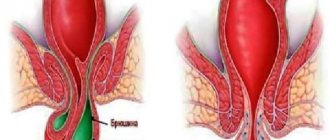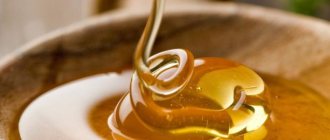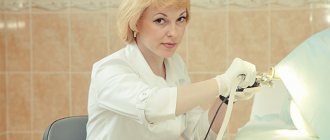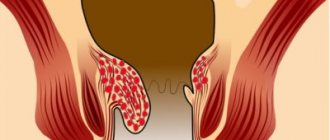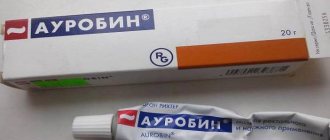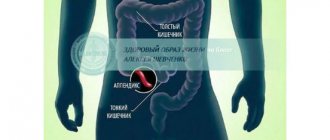A lump has formed.
If hemorrhoids become inflamed, what should you do? People have been suffering from hemorrhoids for many years. Sometimes exacerbations disappear, but after a while the pain and discomfort reappears. However, hemorrhoids cannot resolve on their own without effective therapy, and this should be taken into account, since dilated veins cannot shrink.
What to do at home if hemorrhoids become inflamed? First of all, you need to conduct an examination and consult a doctor. Hemorrhoids are a venous disease of the rectum. When hemorrhoidal nodules appear, exacerbation of hemorrhoids is diagnosed. If hemorrhoids suddenly become inflamed, what should you do? Only a doctor can answer this question after identifying the stage of the pathology, determining the severity and course of the disease.
Hemorrhoidal cones, even after effective treatment, are difficult to get rid of. Sometimes patients experience hemorrhoids once and it doesn’t bother them anymore. However, in some cases, the disease is complicated in addition to pain, burning, redness of the anus with bleeding. Sometimes, due to large blood loss, patients use feminine pads.
Causes of inflammation of hemorrhoids
Why are hemorrhoids acutely inflamed? There are several main factors that may cause hemorrhoidal exacerbation:
Burns in the ass
- Vascular diseases - varicose veins flare up in weakened vascular walls. When stagnation occurs in the organs located in the pelvis, the pressure inside the abdominal cavity increases slightly, which provokes the onset of an inflammatory process in the anus. During bowel movements (diarrhea or constipation), patients' mucous membranes are injured and hemorrhoids become inflamed.
- A sedentary life is a serious reason why hemorrhoids can become inflamed. The pelvic muscles need physical stimulation, otherwise they weaken.
- Unbalanced diet - due to the abuse of salty, spicy and alcoholic foods, redness of the anus area is observed. Dry food, eating fast foods, and snacking provoke dysbacteriosis - symptoms in the intimate area worsen.
- During pregnancy in women with a long term, hemorrhoids may become inflamed. This phenomenon is caused by an enlarged uterus, which puts pressure on the capillaries in the pelvis, disrupting microcirculation. With inflamed hemorrhoids, after emptying, the anal canal is irritated by the use of toilet paper.
Experienced drivers may become inflamed with hemorrhoids; this is an occupational disease, since drivers spend most of their time behind the wheel (congestion in the pelvic organs).
First steps
Inflammation of hemorrhoids can take you by surprise at any time - on holidays, outside the city, during a trip. How to treat the disease in this case? There are many ways, but at the first opportunity it is better to visit a specialist - then there will be no complications, and treatment will bring a speedy recovery.
You need to start with changing your lifestyle and diet.
- Hemorrhoids can become inflamed due to frequent constipation, so you need to improve your diet. It is useful to include fruits, boiled or stewed vegetables, fermented milk products, and dried fruits. Salty, spicy, fried foods, seasonings, marinades are excluded - they further provoke congestion in the veins of the final section of the rectum.
- You need to drink as much fluid as possible (at least 2 liters per day). It is useful to eat natural juices, compotes, and broths made from lean meats. You cannot drink carbonated drinks, coffee, tea, cocoa.
- If you suffer from persistent constipation, you can use laxatives. Some of them begin to work within a few minutes, others take some time to cleanse the intestines.
- It is useful to do special gymnastics. You can't lift weights.
- The main rule in the treatment of hemorrhoids is hygiene. It is recommended to wash yourself with cool water after each bowel movement.
Advanced hemorrhoids are difficult to miss: the patient’s condition worsens sharply, appetite disappears, hemorrhoids begin to become inflamed and fall out, but do not set back. Acute pain accompanies not only the act of defecation, but also any movement, bleeding becomes severe.
Signs of inflammation of hemorrhoids
The first sign of worsening hemorrhoids is redness around the anus. The signs of the inflammatory process are different for everyone, it depends on the course of the disease and the causes of its occurrence. Common symptoms of inflammation of hemorrhoids include burning sensations and pain, rash on the anus, swelling, and redness. Feels a tickling sensation in the anus; during a rectal examination, dense formations are felt. There is inflammation of the skin near the anus.
During defecation, hemorrhoids may become inflamed and bleed; some patients complain of increased temperature:
Worried about hemorrhoids
- Primary degree. At the beginning of the disease, patients with hemorrhoids do not have inflammation or discomfort in the anus. After eating spicy, salty, smoked foods or alcohol, signs of inflammation are not noticeable, and there are no symptoms after exercise or bowel movements. External hemorrhoids of the initial stage are characterized by compactions, which people pay little attention to. Delaying the start of treatment has a detrimental effect on health: thrombosis of nodes with further inflammation. What to do at home if external hemorrhoids worsen? Corrective measures can be taken after examination by a doctor.
- At the second stage of hemorrhoids, prolonged pain appears not only during movement, but also at rest (sitting, lying down). With each bowel movement, patients feel a rush of blood to the rectum, and the hemorrhoidal node may become inflamed during bowel movements; it bleeds, swells, protrudes outward, swells, and hurts. Patients complain of increased temperature (a sign of inflammation), a burning sensation in the butt, and a burning sensation in the perineum.
- Failure to seek medical help in a timely manner provokes worsening of hemorrhoids, leading to the transition to the third stage of the disease. A severe form of hemorrhoids is characterized by difficult bowel movements with severe pain; while moving, patients feel as if they have soap left in their butt (the presence of foreign matter). In men, due to hemorrhoids, urological pathologies and white plaque in the anus are observed. The nodes turn from white (candidiasis) to dark, which indicates necrosis; patients lose their ability to work due to unbearable pain.
The course of the disease is individual, but if the disease has progressed to stage 3, urgent hospitalization is necessary, otherwise more serious complications will appear that are dangerous not only for the general health, but also for the lives of the patients.
How to treat purulent hemorrhoids
Purulent hemorrhoids are a consequence of the appearance of thrombosis in the nodes. This manifestation of the disease is always associated with “paraproctitis”. It is characterized by pus affecting the tissues around the rectum.
Treating purulent hemorrhoids is extremely difficult. Among the reasons that provoke its appearance:
- bacterial infections affecting intestinal tissue;
- cracks in the mucous membrane of the anal area;
- thrombosis in hemorrhoids.
If the disease is not treated, the pus can spread into the pelvic cavity.
Often, oncological tumors become provocateurs of the disease. The process of disease development is accelerated by various gastrointestinal pathologies, imbalance of intestinal microflora, obesity and a sedentary lifestyle. In medical practice, there have been cases where women experienced purulent discharge after childbirth.
Manifestations of the disease depend on the stage of its development. In addition to pus flowing from the anus, the patient may experience:
- high fever, nausea, weakness;
- severe pain;
- the formation of pustules on the walls of the rectum.
The person loses his appetite. In severe forms of the disease, patients experience:
- false urge to have a bowel movement and severe pain during bowel movements;
- discharge of pus;
- severe burning in the anal area.
Hemorrhoids increase significantly in size
Purulent hemorrhoids can be treated in the traditional way and using traditional medicine methods. In any case, consultation with a doctor is required. When starting to fight the disease, you should remember that extremely advanced forms of hemorrhoids can only be gotten rid of surgically.
As the disease progresses, it can cause inflammation in the vaginal area in women, and inflammation in the urinary tract in men. Timely consultation with a doctor allows you to avoid serious consequences and quickly get rid of hemorrhoids.
In traditional medicine, the following are used to treat hemorrhoids: creams, rectal suppositories, ointments, various baths and lotions. The duration of treatment depends on the degree of neglect of the disease. The treatment method is selected by the doctor after a thorough examination of the patient. The entire therapy process is signed by a proctologist. The treatment itself should take place under his supervision.
Rectal suppositories show the highest degree of effectiveness in the treatment of purulent hemorrhoids. They are inserted into the rectum and dissolve under the influence of body temperature. The best candles are:
Treatment with these drugs helps only at the initial and middle stages of the disease. You need to combine the use of suppositories with taking antibiotics. This will prevent the development of inflammatory processes in the human body.
The delicacy of the disease forces many people to treat purulent hemorrhoids at home using folk remedies. When used correctly, they show good results and allow you to get rid of the disease in a short time.
The main thing in the treatment of hemorrhoids is the regularity of the procedures.
Among the most effective means of combating purulent hemorrhoids:
- baths;
- herbal or honey enemas.
The procedure is carried out every day for 10 minutes before bedtime. To prepare a healing solution for baths use:
- 5 liters of boiled water;
- 1 tablespoon each of baking soda and salt.
The healing solution is prepared from 2 liters of cow's milk. It is poured into 2 medium-sized onions and 3-4 cloves of garlic, after which it is all boiled over low heat for 5 minutes.
To carry out the procedure, herbal decoctions are prepared from calendula, chamomile and dry rowan. This herbal mixture copes well with inflammatory processes occurring in the rectum. You can replace this collection with sea buckthorn or St. John's wort. It is good to treat purulent hemorrhoids with a solution of natural honey.
The rehabilitation period requires compliance with a number of rules. After removal of hemorrhoids, the patient should not include spicy foods in his diet. The duration of the rehabilitation period depends on various factors. Among them:
- individual characteristics of the patient’s body:
- accurate execution of doctor's orders;
- type of operation performed, etc.
With open surgery, the body's recovery period after surgery can range from 4 to 6 weeks. For closed operations – 21 days. During this period, the patient should not lift heavy objects or stay in the cold for a long time.
source
Pus from hemorrhoids is a common and frequent complication. Discharge is especially noticeable during the act of defecation; it comes out of the anus before and after feces. Sometimes blood and pus appear with hemorrhoids; such fluids are noticed both regularly during bowel movements and spontaneously. Purulent hemorrhoids are a consequence of the appearance of thrombosis in the nodes or the result of the presence of paraproctitis (pus affects the tissue around the intestine). The symptom indicates a dangerous human condition and requires timely treatment.
Hemorrhoids with pus are a clear symptom of inflammation in the intestines. The disease has characteristic sensations:
- pain syndrome;
- burning;
- severe itching;
- swelling of the hemorrhoidal area;
- discharge of fluid from the anus.
Hemorrhoids can cause purulent discharge of various compositions.
When a blood clot forms in the area of the hemorrhoid or suppuration of the tissues surrounding the rectum, purulent hemorrhoids occur
Depending on the form of the disease, the affected area and the cause of the disease, there are different forms of hemorrhoids:
- by localization: acute: subcutaneous, retrorectal and submucosal;
- chronic, according to the location of the focus: front, side and back.
- acute: simple, anaerobic, after injury and specific;
- simple;
Not in all cases, hemorrhoids fester; inflammation can occur in a simple form and cause a minimal amount of negative effects.
Hemorrhoids with suppuration are formed due to 3 main conditions:
- the presence of a thrombus in the node. If treated, discharge from hemorrhoids begins only after the inflammatory process worsens. Swelling in the rectal area gradually increases and an abscess appears. The development of inflammation leads to the formation of a blood clot, which contributes to the appearance of swelling in the nearby area. Necrosis and festering hemorrhoids soon appear;
The appearance of such a pathology indicates the presence of severe inflammatory processes in the rectum
- paraproctitis in purulent form. Refers to inflammation in the intestines, but in a complicated form. When the disease appears, the quality of the microflora of the stomach and intestines is disrupted. Soon the prerequisites for the appearance of acute and severe forms of inflammation appear;
- anal fissures trigger processes with negative consequences for the intestines. Purulent discharge from hemorrhoids does not appear for no reason; they are complications from the long-term chronic course of the disease.
The discharge of pus is not always provoked by suppuration of the nodes; there are other disorders in the body that provoke a similar condition.
Purulent discharge and hemorrhoids can provoke the following conditions:
- Ulcerative colitis is an acute inflammation localized in the gastrointestinal tract. The disease is often accompanied by patches of blood in the mucus;
- the presence of tumors regardless of their quality;
- fistula of the perirectal space. Pus is not released from the anus, but through the fistula. It can be seen just behind the nodes;
- negative reaction of the body to surgery performed in the rectal area or intestines. This is a dangerous condition because the pus from hemorrhoid removal leads to the opening of the area where the operation was performed. Feces with all dangerous microorganisms can enter the site of the intervention, which creates a risk of various complications.
The disease is a consequence of a passive lifestyle, excess body weight, consumption of large amounts of junk food, alcoholic beverages, etc. Hemorrhoids appear in half of all women after childbirth.
Discharge from hemorrhoids - symptoms:
- discomfort in the hemorrhoidal area;
- burning and itching are manifestations of mucous secretions that have an irritating effect on the skin. The appearance of fluid is a consequence of the inflammatory process in the walls;
- bleeding occurs in most cases of the disease. It can be almost invisible, and given the appearance of fluid only after bowel movements, blood may not be noticed. To determine the presence of blood clots, you need to examine the surface of the stool. In some cases, drops or stream may appear after defecation;
- nodes falling out. Initially, the symptom becomes noticeable only with severe stress, often with constipation. Over time, loss occurs every time you have a bowel movement, and then for no apparent reason or with minimal exertion. At the initial stages, the nodes do not require reduction; they return on their own. If the condition worsens, you have to contact a specialist for adjustment.
If the listed symptoms appear, perhaps some of them, you need to contact a proctologist. The delicacy of the problem leads to embarrassment for some patients, which is why people often seek help in the later stages of the disease. As it progresses, the risk of complications increases.
The disease manifests itself as pain, burning and itching in the anus
The appearance of paraproctitis can be provoked by the general condition of the body or illness. Among the main causes and risk factors:
- decreased immune function;
- exhaustion of the body;
- chronic pathologies;
- infectious diseases of the gastrointestinal tract in chronic or acute form;
- frequent diarrhea or constipation;
- proctological diseases: simple hemorrhoids, fissure, papillitis, proctitis, cryptitis.
Pus from hemorrhoids can also mask other diseases that affect the intestines.
An abscess with hemorrhoids should be treated only under the supervision of a proctologist. With timely treatment, a specialist will help prevent complications and speed up recovery. Based on what pus looks like in hemorrhoids, you can learn about the involvement of other organs and the degree of neglect of the condition. As the source of inflammation spreads, the pelvic organs are involved in the pathological process. For men, the most common lesion is the urinary canal, and for women - the vaginal area.
source
Purulent hemorrhoids are a delicate and very unpleasant problem that a huge number of people face.
It is very common, however, even those who suffer from this problem try not to advertise it and fight with their own methods, which does not always lead to a successful result.
A particularly unpleasant and, at the same time, dangerous stage of this disease is the appearance of pus. Purulent hemorrhoids can be dealt with successfully and quickly if you take the right measures.
Let's look at the reasons for the appearance and development of hemorrhoids:
- Passive lifestyle.
- Excessive consumption of spicy foods.
- Problems with obesity.
- Alcoholism.
- It is also often a consequence of childbirth.
Purulent discharge from hemorrhoids occurs because the patient did not take care of timely treatment for this unpleasant disease, did not consult a doctor and, most likely, did not take basic measures to combat the disease.
After all, pus appears already at the third stage of the disease, which can be called advanced . Fortunately, this is not as critical as it seems, so treatment will not take much time.
Pus can appear for two reasons. Both of them are associated with delayed therapy:
- The occurrence of blood clots in hemorrhoids. As a rule, it causes swelling and the appearance of pus. This leads to the development of the following disease;
- Paraproctitis with discharge of pus. It is caused by thrombosis, wall rupture, inflammation or mixed microflora. It is this term that is most often referred to as hemorrhoids with the discharge of pus.
Pus is a truly alarming sign, so its appearance should force even the most careless patient to turn to specialists, because it is difficult to cure such an illness on your own, and therapy will take much longer.
The fact is that when such discharge appears, there is a high risk that the pus will spread to areas of the pelvis, where it will cause inflammation and swelling .
A symptom of purulent hemorrhoids is not only the presence of discharge, but also an increase in body temperature, weakness and other signs inherent in intoxication.
There may be false urges to go to the toilet “in a big way.” All this indicates the seriousness of the problem. Therefore, do not delay treatment!
If purulent hemorrhoids are in a completely advanced stage, then there is no alternative to the surgical method.
During the operation, the doctor opens the abscess, removes the discharge, and only then carries out the usual manipulations for the treatment of hemorrhoids.
As a rule, a person feels almost instant relief : body temperature normalizes, symptoms of body poisoning disappear.
But it is quite possible to do without surgical intervention if you go to a specialist in time.
Treatment of purulent hemorrhoids can be carried out with medication. However, the therapy process must be prescribed by a doctor. It is advisable that he monitor the progress of treatment.
As a rule, enemas or suppositories are used to treat this disease; they penetrate well directly into the intestine, making them more effective than any other method of drug treatment.
Antibiotics against purulent inflammation in hemorrhoids will also be necessary. After all, the discharge contains a huge amount of harmful substances that simply clog the body. Because of this, more than serious harm to the patient’s health can be caused.
As a rule , when intoxicated, the body is weakened and resists illnesses extremely sluggishly. Therefore, it is necessary to take a course of antibiotics to destroy harmful bacteria inside the body.
In addition, if the patient has a high fever, he is also prescribed a similar method of therapy. Remember that only a doctor determines what medications and ointments to use for purulent hemorrhoids, so do not pay attention to advertising that promises to get you back on your feet in one sitting.
Also, in support of drug treatment, you can use folk remedies that will help you cope with the disease faster, using the power of nature.
There are several good options for treating hemorrhoids with purulent discharge at home:
- Salt baths: a tablespoon of salt and soda is diluted with 5 liters of water, after which you immerse yourself in this solution for 10 minutes. This procedure will help reduce pain and pus discharge;
- Also, instead of salt, you can use various decoctions of rowan, yarrow, calendula, chamomile, and St. John's wort for baths. These plants help reduce inflammatory processes, so that discharge will not bother you;
- Enemas with a small amount of honey or the above-mentioned decoctions help greatly, because this way the active substances penetrate better into the affected area, which means the effect is more effective.
To ensure that purulent hemorrhoids no longer bother you, you should normalize your diet and eliminate the consumption of alcohol and spicy foods. It is also recommended to engage in regular physical activity and avoid spending large amounts of time sitting.
All this will help you say goodbye to paraproctitis forever and forget about purulent hemorrhoids!
source
If hemorrhoids are not treated, they will develop serious complications within a few months or years. Often in the third, advanced stage, purulent hemorrhoids begin, characterized by purulent discharge from the anus. They indicate the presence of serious inflammatory processes in the intestines, usually of an infectious nature. It will no longer be possible to heal on your own. You need to be prepared even for surgery.
In addition to purulent discharge, often mixed with mucus or blood, the clinical picture is associated with intoxication of the whole body:
- temperature rises;
- chills begin;
- weakness appears;
- the general condition deteriorates significantly.
In addition, the symptoms of purulent hemorrhoids are:
- Constant urge to urinate. They are called tenesmus and are false and painful. They are associated with oncological processes in the rectum and should cause serious concern.
- Softening of the skin around the anus, their maceration. Gradually, erosions, ulcers, and extensive internal and external cracks form.
- Severe pain and discomfort when moving and at rest. Itching and burning intensify, and the amount of pus secreted increases.
Very often, purulent hemorrhoids are associated with paraproctitis, acute or chronic. In this case, the symptoms depend on the form of the disease.
- During the acute stage, an abscess or abscess forms. It comes in different locations and sizes. Accompanied by pain and fever, which quickly stop after opening.
- When the acute form transforms into a chronic form, the danger lies in the formation of fistulas - non-healing channels through which pus was released before the operation. There is almost no pain. But after a while, if not fully treated, inflammation begins again and a new acute relapse of the disease.
Hemorrhoids can fester for several reasons.
Experts talk about two main ones. It manifests itself as a result of inadequate therapy or its complete absence in case of exacerbation of the chronic form of the disease, its relapse.
- the formation of a thrombus, a blood clot that clogs the vessels of the rectum and disrupts the blood supply and outflow of blood;
- swelling of the skin around the anus;
- rapid spread of the inflammatory process to the entire groin area and subcutaneous tissue;
- gradual death, necrosis of the skin;
- increase in painful syndrome;
- the occurrence of acute paraproctitis - acute purulent inflammation of the tissues surrounding the rectum.
The disease never occurs on its own; it is a consequence of pathogenic microflora, usually of a mixed type - staphylococcus, streptococcus and E. coli. It penetrates through anal fissures and wounds into the intestinal mucous tissue, causing inflammatory processes that are accompanied by the release of pus, mucus and blood.
Pus from the anus can be released not only with hemorrhoids, but is often associated with other, no less serious diseases. You need to know and remember about this in order to contact a specialist in time and start treatment.
Purulent discharge is characteristic of:
- nonspecific ulcerative colitis;
- Crohn's disease;
- neoplasms of a benign or malignant nature in the lower part of the large intestine;
- pararectal fistulas left after acute paraproctitis;
- complications in the postoperative period as a result of infection entering an unhealed wound.
Getting rid of purulent hemorrhoids is not very easy. This requires time, the professionalism of the doctor, patience and the desire of the patient.
With purulent hemorrhoids, inflammatory processes spread very quickly and lead to complications in the form of acute paraproctitis and the formation of fistulas, which may never heal. The pain will intensify and you will have to undergo surgery to remove the hemorrhoids. A long rehabilitation period will be required, fraught with multiple complications.
There is a high probability that the pus will spread to the entire pelvic area, causing discomfort and swelling there too. In men it is the urethra, in women it is the vagina.
Based on medical history, examination and tests, the proctologist will prescribe either general therapy with antibiotics or surgery to open the abscess.
How to treat purulent hemorrhoids, how much it is possible to help yourself and why it is better not to do this, read further in the article.
If the suppuration is still small and the patient seeks help immediately when it appears, the doctor prescribes a course of treatment. Medicines are selected individually, mainly antibiotics and anti-inflammatory drugs - rectal suppositories or ointments.
Treatment lasts no more than 5 days. If during this time the clinical picture does not improve, but worsens, surgery is prescribed.
The doctor first opens the abscess to make the patient feel better and places a drainage.
After some time, another operation will be required to remove the hemorrhoid itself.
And if purulent hemorrhoids give rise to complications in the form of chronic paraproctitis, then the resulting fistulas should also be removed. Otherwise, the inflammation will recur.
The more advanced purulent hemorrhoids are, the more time it takes to treat and restore the body. And he was very weakened during this period. That is why it is necessary to take vitamins, minerals, immunomodulators, and adjust your lifestyle and diet.
All these measures are part of general therapy, the rehabilitation period after operations and are aimed at improving the health of the body and eliminating relapses.
Definitely, treating hemorrhoids with pus at home will not get rid of the problem, but will only worsen it.
The only exception can be a situation in which the patient uses traditional medicine recipes together with therapy prescribed by a doctor and under his supervision.
The specialist himself will recommend such procedures if he deems it necessary.
In severe cases of the disease, the post-surgical period lasts a long time. Complications may occur, including purulent discharge with mucus after surgery to remove hemorrhoids. The reason is the penetration of infection from stool into unhealed wounds, internal or external cracks of the rectum.
Photo: purulent hemorrhoids
To reduce the risk of danger, the patient is usually advised to:
- Perform simple physical exercises that do not require much effort. Therapeutic exercise helps restore blood microcirculation in the pelvic organs.
- Use a mild laxative before each bowel movement, so as not to injure the mucous membranes or cause cracks to appear when pushing. It is better if it is a natural preparation based on plant materials.
- Strictly observe the rules of personal hygiene, constantly monitor the cleanliness of the perineum, and use antibacterial care products.
- For some time, follow a special diet of easily digestible foods that have a laxative effect.
The diet for purulent hemorrhoids must be followed regardless of whether there has been surgery or not.
Include in your diet daily:
- red rowan juice 100 ml before each meal;
- boiled beets on an empty stomach;
- also, on an empty stomach, you can drink a glass of freshly squeezed carrot juice;
- Sauerkraut brine should be taken during constipation, discharge of pus or blood. A glass three times a day.
Smoked meats, marinades, spicy, salty, fatty foods, alcohol and carbonated drinks should be excluded.
4 basic rules of nutrition for purulent hemorrhoids:
- The diet is preferably light and healthy, rich in vitamins, minerals and fiber.
- Products should improve intestinal motility and digestion.
- Eat little, but often, at least 5 times a day.
- Maintain a drinking regimen to soften stool.
Purulent hemorrhoids are much easier to cure if they are not advanced. Don't be shy or complex. It is better to see a doctor as soon as possible than to go through a long difficult path of treatment and recovery later.
source
There is no point in delaying visiting a proctologist if you have obvious symptoms of rectal disease. Often, self-medication and measures taken at the wrong time lead to the appearance of purulent hemorrhoids (paraproctitis). Dealing with a serious illness is difficult, especially since it is accompanied by severe pain.
Purulent hemorrhoids can be chronic or acute. Symptoms for both diseases can differ radically.
Signs of acute paraproctitis:
- First of all, the patient will be identified with all signs of the inflammatory process. Increased body temperature, joint pain, lack of appetite, problems with the natural passage of urine and feces.
- With a subcutaneous abscess, swelling, severe redness, and thickening of the tissue appear in the problem area. The pain may not allow the patient to sit; if pressure is applied to the area, the discomfort intensifies.
- A purulent formation under the mucosa does not have such a pronounced pain syndrome. There is also no high temperature. The abscess ruptures into the rectum.
- The pelvic-rectal form is dangerous because the symptoms are almost no different from any infectious diseases. Often, before seeing a doctor, the patient self-medicates for a cold, mistakenly assuming it is present.
- With the ileo-rectal type, symptoms can be detected only after a week. The buttocks will become different sizes, and the area in the affected area will become inflamed and red.
- Necrotizing paraproctitis is recognized as the most dangerous form. The patient's skin may turn blue, blood pressure decreases, and soft tissue dies. The patient receives severe intoxication, accompanied by severe pain.
Signs of chronic paraproctitis:
- painful sensations during bowel movements;
- itching and irritation in the area of the anus;
- purulent and fecal discharge from the fistula tract;
- constant inflammatory process
- presence of a fistula.
Each type of paraproctitis has its own characteristics, which are used to diagnose the disease. Moreover, each course of purulent hemorrhoids has its own types.
Acute paraproctitis can be:
- Submucosal, retrorectal, pelviorectal, subcutaneous and ochiorectal. Separation occurs depending on the location of the purulent abscess.
- Ordinary, traumatic, anaerobic or specific. Determined by etiology.
Chronic paraproctitis is also called rectal fistula, and it comes in several subtypes:
- Simple or complex, classification based on severity.
- Posterior, lateral, anterior, determined by the location of the internal abscess.
- Complete, incomplete, internal or external, depending on the anatomical principle.
Today, among the proctologist’s patients, there are many women with this problem. This is due to the fact that they have a great love for tight-fitting outfits, as well as thong panties made of thick fabrics.
The main factors that influence the occurrence of purulent hemorrhoids are:
- poor nutrition;
- lack of active movements;
- problems with stool;
- infectious problems of the digestive system;
- pathological phenomena of proctology.
The only effective way is considered to be an operation that will eliminate paraproctitis of any course. During surgery, it is recommended to use full anesthesia.
Complete recovery of the patient is possible if the purulent formation was opened with
its subsequent drainage. To ensure that the infectious process does not spread further, the surgeon will have to excise the crypt with the inflammatory process.
It is noted that in medical practice radical measures are rarely taken. Most often, the purulent formation is opened and drainage is installed. Because of this, there is a high risk of fistula formation and relapse of the disease.
In case of a chronic course of the disease, the patient is indicated for antibiotic therapy after surgery. The presence of infiltrates implies physical treatment.
There are situations when a surgical solution to the problem is not indicated due to personal reasons. Then patients seek to help themselves at home. If the disease does not develop into an acute form, then traditional medicine recipes can bring relief.
It should be taken into account that in the early stages, it is possible not to open the purulent formation with the help of a medical professional. Some recipes allow the abscess to release itself. The main thing is to see your proctologist for an examination so that he can assess the current situation. Typically, the doctor treats the wound, removes secretions, and administers therapy to prevent the formation of a fistula.
Traditional medicine involves treating purulent hemorrhoids with an enema, a medicinal bath and herbal teas.
There are effective solutions for a healing bath:
- 2 onions and 4 cloves of garlic are poured with 2 liters of warm milk. The mixture is boiled for 5 minutes, then cooled to room temperature. When using this decoction for a bath, the patient's body should be kept warm.
- 10 tablets are dissolved in a glass of clean boiled water mumiyo. The finished liquid is filtered and added to 5 liters of warm water.
- 5 liters of distilled water, to which a tablespoon of salt and soda . 15 procedures are enough to achieve a therapeutic effect. After taking a therapeutic bath, you need to apply an ointment prescribed by the proctologist, usually ichthyol.
Tampons that need to be soaked in a special decoction also provide benefits for the patient. You can also introduce liquid using a microenema. For it you will need juice from high-quality and peeled potatoes ; 1 tablespoon is needed for 1 procedure. The course lasts 10 days, manipulations are carried out before bedtime.
To get rid of the cause of the disease - cryptitis, sphincter paresis is required. To achieve the goal, the specialist performs a posterior sphincterotomy, in which the affected area is dissected. If the walls of the rectum have obvious defects, then it makes sense to use the ligature method for treating purulent hemorrhoids.
Opening an abscess involves making a semilunar incision, which should be
extended on both sides. After this, an ellipsoidal incision is required closer to the rectum to achieve excision of the defective sinus. Externally, through the incisions made, a ligature is placed into the rectum. Laying is done along the midline in front or along the back of the anal canal. After which the thick ligature is tightened.
After a few days, the ligature cuts through some of the sphincter fibers and is tightened again. The procedure requires regular repetition, contributing to the elimination of the fistula, but there is no violation of the closing ability of the sphincter.
Elastic type ligatures are used more often, as they destroy the sphincter fibers over a longer period of time. This has a positive effect on the treatment and the final result.
source
Possible complications
Despite redness around the anus and other signs of inflamed hemorrhoids, patients do not immediately seek medical help.
As a result, patients are doomed to experience complications:
Factors of occurrence
- Thrush developing in the anus - a fungal infection is dangerous for infecting other organs and systems of the body. This can cause hemorrhoids to become inflamed.
- Slight redness of the anus leads to massive blood loss, which is dangerous for the development of anemia.
- A simple tickling in the anus can result in thrombosis of the internal or external hemorrhoid. The resulting inflammation in the tricky veins in the form of blood clots is accompanied by severe pain and swelling. In some cases, surgery is indicated.
- Hemorrhoids can become inflamed and develop into an abscess (pararectal). Inflammation in the subcutaneous fat layer is dangerous due to the development of a purulent process that turns into sepsis.
- Prolapsed nodes are an inflamed node that can fall out of the anal canal over time, thereby impinging on the base of the rectal valve muscles. This phenomenon is very painful.
- Tissue necrosis is a consequence of inflammatory processes with thrombosis. The pinched nodes die, turn black, and a foul odor is felt from the anal canal.
At the first signs of inflammatory processes in the anal canal, you should immediately seek medical advice. The disease cannot be allowed to develop undesirable consequences. After examination and examination, an experienced specialist will select effective treatment therapy.
Causes
The pathology most often affects women. This is explained by the fact that representatives of the fairer sex wear thong panties and close-fitting clothing made of dense material. Other factors influence the development of the disease:
- abuse of spicy and unhealthy foods;
- lack of physical activity;
- problems with bowel movements;
- pathological phenomena of proctology.
The formation of purulent paraproctitis can be accompanied by infectious diseases of the digestive system.
How to cure inflammation of hemorrhoids
Doctor for delicate problems
What to do if hemorrhoids suddenly become inflamed? The first step is to undergo a medical examination. The doctor will examine the inflamed hemorrhoids and make a verdict on how to treat the pathology. To eliminate redness near the anus, local medications are usually prescribed (conservative therapy). To quickly relieve hemorrhoidal inflammation at home, proctologists prescribe the use of suppositories or ointments to relieve the inflammatory process.
In severe cases, an aggravated disease with severe pain symptoms is treated with tablets and anesthetic injections. How else can inflamed hemorrhoids be treated at home? The pharmacy chain offers a wide range of all kinds of antihemorrhoidal drugs, so prescriptions are made only by a doctor, taking into account the characteristics of the course of the pathology, the patient’s age, complaints, and existing symptoms.
Diagnosis and treatment
Similar symptoms are observed with perianal dermatitis in an advanced stage, genital warts. But in most cases, purulent discharge in the stool indicates a serious illness that requires prompt diagnosis and treatment.
Pus found in stool should be an immediate reason to contact a proctologist. Patients are often embarrassed to consult a doctor with this delicate problem, but delay in some cases can cost the patient his life.
Diagnosing hemorrhoids at an early stage reduces the risk of developing serious pathologies and significantly speeds up the healing process.
Ridding the patient of purulent discharge is not aimed at eliminating symptoms, but at treating the disease that caused them. If you have hemorrhoids with pus, you should not self-medicate.
When choosing a treatment method, the diagnostic results, medical history, concomitant ailments, age, and lifestyle are taken into account.
The result of complex treatment should be the prevention of relapses and restoration of the patient’s immunity. The patient’s task in this case is to correct the lifestyle and follow all the proctologist’s instructions.
Surgical treatment of hemorrhoids with pus is a last resort if the prognosis is poor or the disease is severe. In most cases, timely consultation with a doctor helps to avoid surgical intervention.
Anti-inflammatory ointments
If hemorrhoids are severely inflamed, external treatment is prescribed. To eliminate hemorrhoidal inflammation, it is recommended to use non-steroidal anti-inflammatory drugs (NSAIDs, NSAIDs).
For the treatment of hemorrhoids, the following medications are prescribed in the form of ointments:
Healing ointment
- Heparin;
- Vishnevsky;
- Troxevasin;
- Levomekol;
- Proctosan;
- Hepatrombin G;
- Ultraproct;
- Relief.
External as well as internal hemorrhoids are treated with ointments. The ointment is applied inside using the applicator attached to it. Some remedies help relieve inflammation, relieve pain, stop bleeding, and strengthen vascular walls. Prescriptions are made by the attending physician on an individual basis. There are also hormonal drugs to quickly relieve swelling and eliminate the inflammatory process; this group of drugs is contraindicated for pregnant and lactating women.
Anti-inflammatory suppositories
For symptoms of inflamed hemorrhoids inside the rectum, rectal suppositories are more suitable for treatment. Rectal suppositories not only relieve inflammation, but also dissolve formed blood clots, restoring mucous tissue. Intestinal itching and burning in the rectum quickly disappear. Burning and pain in the intestines are quickly eliminated by suppositories, since the product immediately reaches the damaged tissue and begins to act. How to treat inflamed hemorrhoids and how to get rid of inflammation? Hemorrhoidal inflammation can be cured with natural preparations in the form of suppositories. A network of pharmacies sells suppositories with ichthyol, sea buckthorn oil, and belladonna extract for these purposes.
In case of severe damage to the rectal mucosa, specialists prescribe agents with a wide range of effects. Such suppositories include:
Rectal suppositories
- Proctosan;
- Relief (ultra);
- Proctosedyl;
- Ultraproct;
- Relief;
- Gepasolone.
Anti-inflammatory drugs in the form of suppositories are prescribed by the doctor after examination. Pregnant women and patients with chronic pathologies in the body should be especially careful when choosing medications.
Anti-inflammatory pills
How to treat inflamed hemorrhoids? In case of aggravated hemorrhoids, anti-inflammatory drugs are prescribed, also in tablet form.
The best non-steroidal drugs:
Painkillers
- Ibuprofen;
- Nise;
- Ketonol;
- Diclofenac.
Why do hemorrhoids become inflamed in women and how to treat them? If the cause of hemorrhoidal disease is varicose veins in the hemorrhoidal veins, specialists prescribe medications with a venotonic effect. Such tablets include Detralex, Phlebodia 600, Venarus, Troxevasin.
Female hemorrhoids that begin during pregnancy can be treated with gentle medications or folk remedies. To relieve painful symptoms due to inflammation of the genital organs or fungal diseases, pain-relieving injections in combination with antimicrobial drugs are recommended. With the help of injections you can quickly get rid of pain in the anarectal area. The injections contain novocaine, which relieves pain after just a few manipulations. Injections are given in the tailbone area.
How to relieve inflammation of hemorrhoids at home
How to relieve inflammation of aggravated hemorrhoids at home? There are alternative medicines for this.
Method 1. How to relieve inflammation of hemorrhoids quickly at home? Few people know that mustard is an effective treatment for hemorrhoids. Treatment of hemorrhoids with ordinary mustard is due to taking a medicinal bath with this product. For these purposes, dry raw materials are used, sold in pharmacies.
To prepare the bath you need:
- dry mustard - 4 tablespoons;
- glass jar with a volume of 3 liters;
- blanket or blanket;
- towel;
- bucket (enamel).
How is the procedure performed? Mustard is poured into a glass jar, which should be filled to the top with boiled water. The enamel bucket is wrapped with a towel around the edge, and the prepared mustard solution from a three-liter jar is poured inside. The patient should sit on a bucket over steam. The steam should enter the anal canal. To prevent steam from evaporating from the bucket, the patient is covered with a blanket or blanket, wrapped to the waist.
The duration of the first session should not exceed a quarter of an hour. Initially, patients complain of pain during the procedure, but they can withstand it. Such sessions are done 3-4 days in a row. Before starting treatment sessions with mustard, you should consult a proctologist. There are pathologies for which thermal procedures are prohibited.
Method 2. When hemorrhoids become inflamed, how to treat them at home? Many patients treat hemorrhoidal disease with tobacco. The main active ingredient of this product is nicotinic acid. Nicotinic acid helps with hemorrhoids. Tobacco quickly copes with tissue regeneration and improves microcirculation. Thanks to nicotinic acid, patients' digestive processes are normalized, which prevents constipation and intestinal motility improves.
When applied externally, tobacco-based products destroy pathogenic microflora and eliminate infection. The plant has anti-edematous, analgesic, anti-inflammatory effects. Old forms of hemorrhoids are treated with sedentary procedures in baths with the addition of tobacco.
Baths for hemorrhoids
Tobacco leaves – 3-4 pcs. pour 2 liters of boiled water, the solution cools to 36 degrees. The finished composition is poured into the basin, the patient is immersed in tobacco infusion for 15 minutes. After the session, the anus is lubricated with a specially prepared or purchased medicinal ointment. The solution does not need to be poured out after the procedure; it can be used up to 3 times.
The best results of such treatment are achieved with the use of combined formulations of herbal raw materials. For example, a mixture of herbs is prepared from chamomile, tobacco leaves, plantain and celandine. All herbs are taken in the same quantity. The medicinal composition for baths is prepared from 2 liters of boiled water and 4 tbsp. l. prepared herbal mixture (dry) The infusion is simmered on fire for 8 minutes, after which it cools to an acceptable temperature for taking a bath.
Proper nutrition
With this disease, a special diet must be selected for the patient. The diet can include:
- porridge from dark cereals;
- dietary meat broths;
- crackers without spices (it is better if they are homemade);
- boiled fish;
- fresh vegetables and fruits (in limited quantities);
- baked apples.
Fried, smoked, spicy and fatty foods should be excluded from the diet. You should also stop drinking alcoholic beverages and, if possible, smoking.
Patients must adhere to certain dietary rules:
- All food should be liquid, but high in calories. This is necessary to facilitate the digestion process and strengthen the body.
- It is necessary to eat food fractionally, that is, in parts. It is better to take small portions every 3 hours.
- You need to drink at least 2 liters of fluid per day. It is advisable that it be clean filtered water.
- It is important to exclude fresh baked goods and wholemeal bread from your diet.
- Vegetables that contain starch should be excluded. This is necessary to prevent increased gas formation.
Compliance with these rules promotes a speedy recovery and helps avoid the development of diseases.
Preventive actions
What to do at home if hemorrhoids become inflamed? If hemorrhoids become aggravated and can become inflamed frequently, then you should probably have anti-inflammatory drugs at home; if these are not available in your home medicine cabinet, then you need to purchase them. How to relieve pain from inflamed hemorrhoids? This question should be asked to your doctor. Do not forget that the use of folk remedies is not suitable for everyone; often inflamed hemorrhoids require conservative, fast-acting treatment. Then patients will be able to avoid the chronic form of pathology.

